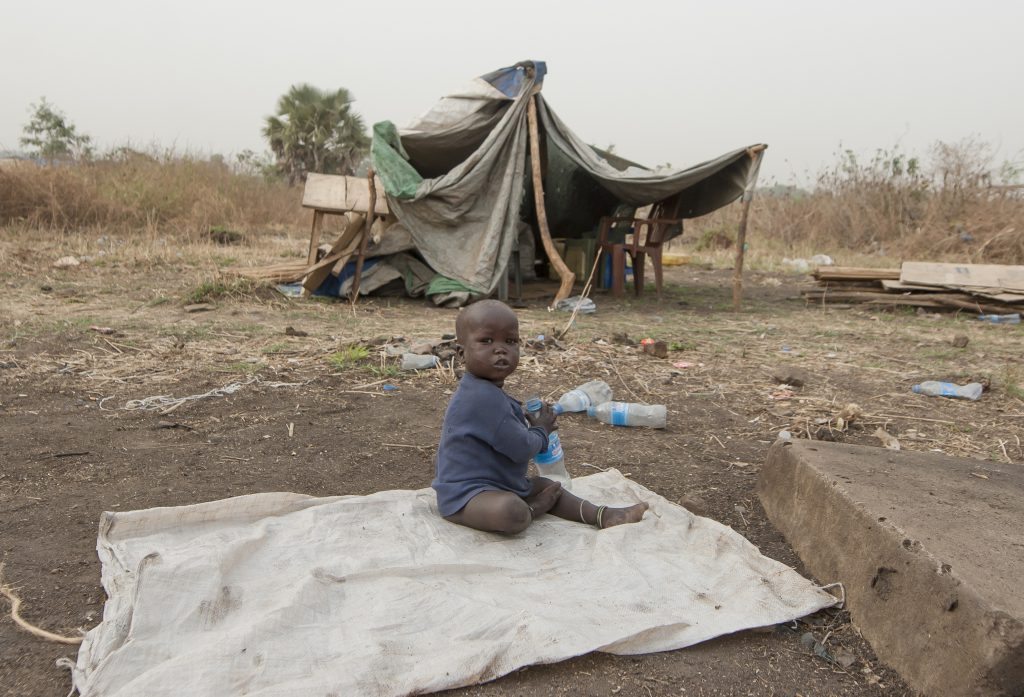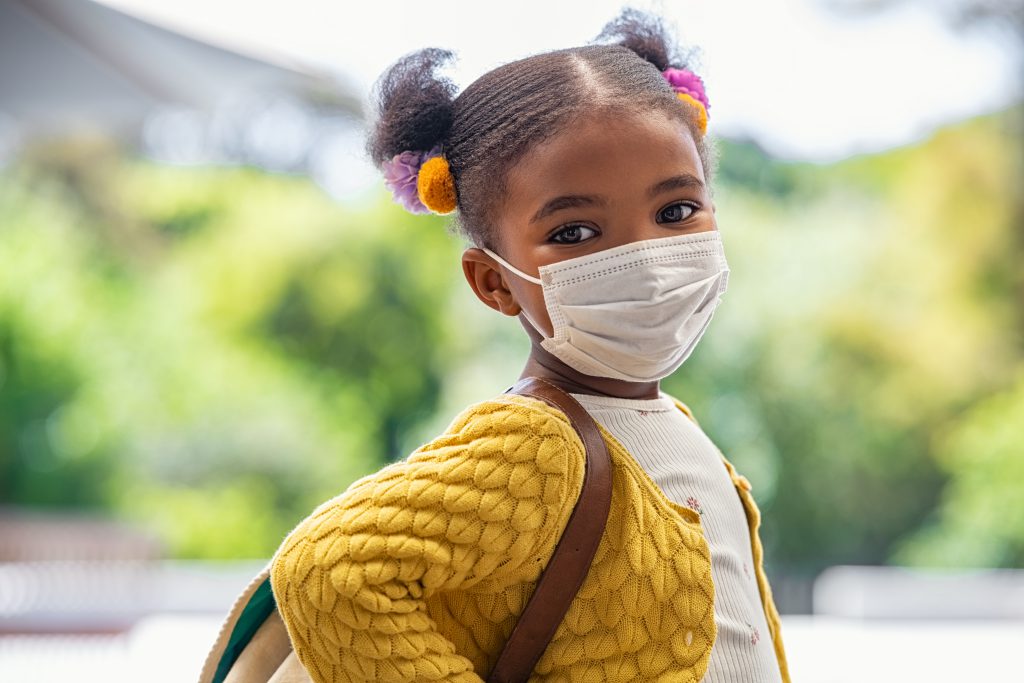While worldwide child mortality rates – defined as “the annual number of child deaths divided by the total number of births in a given region” (Humanium, n.d.) – are decreasing slowly, the Covid-19 pandemic has cast doubt on the permanence of this trend. The pandemic has also had indirect effects on the lives of many children worldwide.
The surprising fall in child mortality post-Covid-19
Research carried out so far suggests that, in reality, the number of child deaths linked to Covid-19 is not as high as could have been predicted. However, it is important to bear in mind both the recent nature of this data and its exhaustiveness.
The World Health Organisation (WHO) states in its report from 30th September 2021 (World Health Organisation, 2021) that Covid-19 cases and deaths remain low among children and adolescents. The United Nations Inter-agency Group for Child Mortality Estimation (UN IGME) collected data on child deaths caused directly by Covid-19 infection in 77 countries in 2020. These results show a clear rift according to age.
The under-25s represent just 0.6% of the total deaths linked to Covid-19; that is, 9,900 deaths in 2020. 27% of these deaths occurred among those aged 0-9, and 42% among those aged 20-24.
It is important to note that this pandemic-related data forms part of a general global trend. A child born today has a much greater chance of surviving to the age of 5 than one born in 1990, but their country of birth will nonetheless have a clear effect on their life expectancy. Global mortality rates among children under 5 are continuing to fall, with the figure at 37 deaths per 1000 births in 2020 (UN Inter-Agency Group for Child Mortality Estimation, 2021).
The data from these countries has been reported and processed with the aim of observing changes (or lack of changes) compared to 2020 trends, and has confirmed that the direct impact of Covid-19 on child mortality remains negligible. As the WHO has pointed out, children have experienced prolonged symptoms, and, in rare cases, Multisystem Inflammatory Syndrome (World Health Organisation, 2021). It is, therefore, crucial to analyse these results in light of all new studies and research in order to establish a more complete understanding of child mortality as a direct result of Covid-19 and to reach up-to-date, reliable conclusions.
The alarming indirect effects of Covid-19 on child mortality
Although effects linked to Covid-19 infection itself are clearly limited, the indirect impact of the pandemic on the economy and on the enlistment and trafficking of children in armed conflicts has provoked urgent concerns. There is a clear divide in these indirect effects not only by age, but also by geographical location. This article will not give an exhaustive list of the indirect effects of Covid-19, but will illustrate two major ways in which they manifest themselves.
Economic shock and child deaths in developing countries
Children, particularly those under 5 years old, are especially affected by economic upheavals, most notably in countries considered poor. These populations do not always have access to safe drinking water, food or decent housing, so their health often becomes highly dependent on the economic situation (Millward, 2022). Consequently, the primary victims of the precautionary measures taken to limit the spread of Covid-19, including border closures, disruptions to food and medical deliveries, and delays in immunisations, have been children (Desmon, 2022).

Famine has affected countries that were already vulnerable, and they have not been spared by the pandemic crisis. This is true for the Democratic Republic of the Congo, north-east Nigeria, Yemen and South Sudan, all of which are moving from a “nutritional crisis to an imminent catastrophe”, according to the former executive director of UNICEF, Henrietta Fore. In Nigeria, around 300,000 children are expected to suffer from severe acute malnutrition, and are at imminent risk of death (UN News, 2020). Afghanistan has seen the reversal of decades of progress towards eliminating preventable child deaths due to disruptions in maternal and infant health services caused by the Covid-19 pandemic, threatening the lives of millions more children once again (UNICEF, 2020).
An increase in child trafficking and enlistment in armed conflicts
The sudden economic recession has not had the same consequences in all countries. While some populations benefit from government assistance, others have been forced to resort to extreme solutions in order to survive. Armed groups have evidently taken advantage of poverty, famine and the decrease in children in education to kidnap and recruit children in large numbers (UN News, 2021).
In Mali, the pandemic has enabled armed groups to take back control of multiple areas, particularly in Gao and Kidal. As a result of this control, 230 children were recruited into armed groups in the first half of 2020, compared with 215 in 2019. The consequences of this tragic situation will include children being raped, sold, enslaved and forced to fight, and, as a result, many of them will inevitably die (UNHCR France, 2020).
In Colombia, despite the 2016 peace agreement signed by the Revolutionary Armed Forces of Colombia (FARC), promises of reintegration are judged not to have been kept, so the FARC has resumed combat. Colombia has also been struck with famine, and during lockdown, the FARC began a wave of recruitment targeting people of all ages, offering sums of money that are difficult to refuse for a civilian population in extreme poverty (ARTE Reportage, 2020). Children who fight for the FARC are at high risk of losing their lives, or they may instead be used by the armed group before being eliminated once they are no longer needed.
Is there hope for the future?
The right to life and to be treated for and protected from illness are rights inherent to every child and are set out in both the UN Convention on the Rights of the Child (UNCRC), which has been ratified by the majority of countries, and in the International Covenant on Economic, Social and Cultural Rights (ICESCR), specifically in article 12. States therefore have the obligation and the duty to respect, protect and implement children’s rights.
However, a series of advances made during the pandemic by governments and supported by a range of institutions should be celebrated (Becker, 2021). Among these are the decrease in the rate of child mortality by 2% since 2020, and by half since the year 2000 (Macrotrends, n.d.). In addition, 45,000 children across 84 countries have been released from detention during the pandemic (UNICEF, 2021). Finally, nineteen plans of action to put an end to the enlistment of child soldiers and other human rights violations have been implemented around the world (United Nations, n.d.).

The indirect consequences of the pandemic for children are still unfolding. As such, Humanium is working to raise awareness of the current situation in terms of children’s rights and the importance of these rights all over the world, so that anyone can take part in this mission – whether through a donation, through sponsorship, or even by becoming a volunteer. Join us!
Written by Morgane Schmutz
Original text revised by Aditi Partha
Translated by Alex Macpherson
Revised by Garen Gent-Randall
Works cited:
ARTE Reportage. (2020). “Colombie : Bogota, les chiffons rouges de la faim.”Consulté sur Arte (Youtube) :https://www.youtube.com/watch?v=7F62qZquNhk&t=3s, consulté le 3 mars 2022.
Becker, J. (17 décembre 2021). “Malgré la pandémie, des avancées pour les droits des enfants.”ConsultésurHuman Rights Watch: https://www.hrw.org/fr/news/2021/12/17/malgre-la-pandemie-des-avancees-pour-les-droits-des-enfants, consulté le 4 mars 2022.
Desmon, S. (23février 2022). “Children Under Five Dying from Economic ‘Side Effects’ of COVID-19 Pandemic.”Consulté surCenter for Communication Programs: https://ccp.jhu.edu/2022/02/23/child-mortality-lockdowns-pandemic-covid19/, consulté le 4 mars 2022.
Humanium. (n.d.). “Convention des droits de l’enfant.”Consulté surHumanium:https://www.humanium.org/fr/convention/, consulté le 4 mars 2022.
Humanium. (1eravril 2020). “Coronavirus – un guide pour enfants en 5 questions.”Consultésur Humanium: https://www.humanium.org/fr/coronavirus-un-guide-pour-enfants-en-5-questions/, consulté le 3 mars 2022.
Humanium. (n.d.). “Mortalité infantile.”Consulté sur Humanium: https://www.humanium.org/fr/mortalite-infantile/#:~:text=Pr%C3%A8s%20de%209%20millions%20d,infantile%20a%20pu%20%C3%AAtre%20enregistr%C3%A9e, consulté le 4 mars 2022.
Humanium. (n.d.). “Pacte international relatif aux droits économiques, sociaux et culturels.”Consulté sur Humanium: https://www.humanium.org/fr/normes/pactes-internationaux-1966/texte-integral-pacte-international-droits-economiques-sociaux-culturels/, consulté le 3 mars 2022.
Macrotrends. (n.d). “World Infant Mortality Rate 1950-2022.”Consulté sur Macrotrends – Population – Infant Mortality Rate: https://www.macrotrends.net/countries/WLD/world/infant-mortality-rate, consulté le 3 mars 2022.
Millward, J. (23 février 2022). “Estimated impact of the 2020 economic downturn on under-5 mortality for 129 countries.”Consultésur PLOS ONE: https://journals.plos.org/plosone/article?id=10.1371/journal.pone.0263245, consulté le 3 mars 2022.
Nations Unies. (n.d). “Children and armed conflict.”Consulté surOffice of the UN Special Representative for Children and Armed Conflict: https://childrenandarmedconflict.un.org/tools-for-action/action-plans/, consulté le 2 mars 2022.
ONU Info. (30décembre 2020).”Des millions d’enfants menacés par la famine en 2021 dans plusieurs pays, dont la RDC, leYémen et le Soudan du Sud.”Consulté surNationsUnies, ONU Info: https://news.un.org/fr/story/2020/12/1085632, consulté le 2 mars 2022.
ONU Info. (12 février 2021).”L’ONU et l’UE jugent urgent de mettre fin à l’enrôlement des enfants dans les conflits.”Consulté sur Nations Unies, ONU Info:https://news.un.org/fr/story/2021/02/1089322, consulté le 2 mars 2022.
UNHCR France. (1er décembre 2020). “Augmentation du trafic d’enfants au Mali en raison du conflit et de la pandémie de Covid-19.”Consulté sur UNHCR France: https://www.unhcr.org/fr/news/press/2020/12/5fc63047a/augmentation-trafic-denfants-mali-raison-conflit-pandemie-covid-19.html, consulté le 3 mars 2022.
UNICEF. (9 septembre 2020). “La Covid-19 Risque D’anéantir Des Décennies De Progrès Pour Éliminer Les DécèsÉvitables D’enfants.”Consulté sur UNICEF: https://www.unicef.fr/article/la-covid-19-risque-d-aneantir-des-decennies-de-progres-pour-eliminer-les-deces-evitables-d, consulté le 4 mars 2022.
UNICEF. (15 novembre 2021). “La remise en liberté durant la pandémie de COVID-19 de 45 000 enfants détenus prouve qu’une justice bienveillante envers les enfants est possible.”Consulté surUNICEF:https://www.unicef.org/fr/communiqu%C3%A9s-de-presse/la-remise-en-libert%C3%A9-durant-la-pand%C3%A9mie-de-covid-19-de-45-000-enfants-d%C3%A9tenus, consulté le 3 mars 2022.
United Nations Inter-Agency Group for Child Mortality Estimation. (Décember 2021). “Levels and trends in child mortality.”Consulté surUNICEF Data: https://data.unicef.org/resources/levels-and-trends-in-child-mortality/, consulté le 2 mars 2022.
World Health Organisation. (30 septembre 2021). “Update 67 – COVID-19 in children and adolescents.”Consulté sur World Health Organisation: https://www.who.int/publications/m/item/update-67-covid-19-in-children-and-adolescents, consulté le 4 mars 2022.


